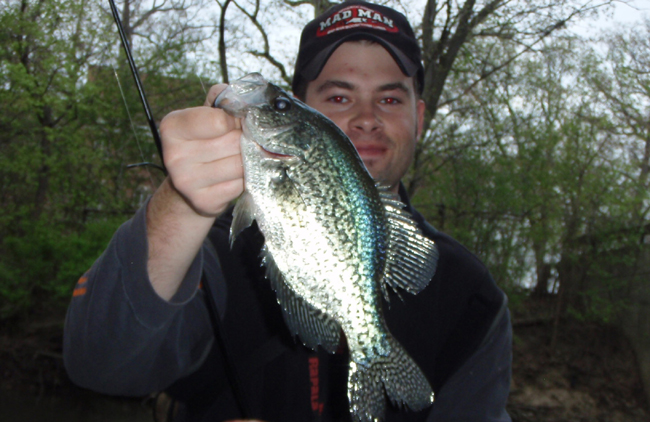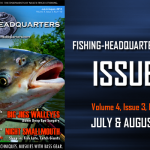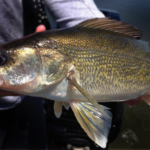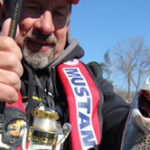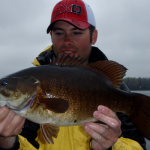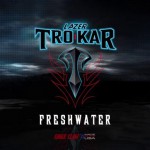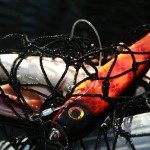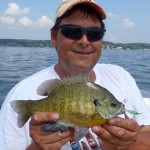By: Andrew Ragas – Date Posted: May 5, 2012
When it comes to crappie fishing, lakes and reservoirs are the most frequented destinations for serious anglers. However, many of them fail to realize that small streams and river systems offer excellent fishing opportunities as well. Rather than fish for crappies by boat on the pressured waters as most do, I often go in a different direction. I wade and fish the smaller rivers and streams.
As tolerable of flowing water and migratory as schooling crappies are in reservoirs, it should not be a surprise to anyone that crappies also inhabit smaller rivers and streams. What’s most surprising of all is that anglers seldom wade for crappies in these accessible waters.

While rivers and creeks throughout the upper Midwest usually teem with more sought after fish species such as bass, walleyes and catfish, crappies are often the second class citizens. Why is that? I know the fishing opportunities for them are underutilized, and the fisheries are never fully taken advantage of.
When I’m not traveling to fish up north or somewhere else throughout the upper Midwest, I fish locally, west of the urban sprawl of Chicago in Northern Illinois. In this region, the lakes and reservoirs are limited in number, but the smaller, low gradient and habitat plentiful rivers and creeks are not. I take what I can get, and crappies from smaller rivers throughout the spring and summer months in the Northern Illinois region is one of them.

Determining Productive Streams
It’s possible that fishable populations of crappies inhabit most river systems. However, certain rivers and streams offer better fishing opportunities than others. In my opinion, there are some important factors which make a stream productive for fishing. The most important ones leading to good crappie fishing are the rate of stream flow (or lack of one), water clarity, depth, and habitat.
Unlike larger, heavier fish species that roam the current and use it to their advantage for feeding and migrating, crappies are a species not built for challenging the flows of a stream. They are nomadic schooling fish that are wildly successful at avoiding current. The best wade fishing I’ve experienced has taken place on small to mid-size rivers with low gradient current. These streams have consistently slow speeds of current and bottom areas entirely comprised with silt, sand, muck, compressed bottom materials, and occasional areas of rock. Low gradient streams usually experience warmer summertime water temperatures that can reach highs of up to 90 degrees. These streams often hold warm water fish species such as largemouth bass and sunfish, along with crappies, as well as northern pike, catfish, carp, suckers and a number of minnow species. Due to the reduced amounts of current in these streams, all species of fish are able to use much of the water column for feeding and migrating.

Most low gradient streams in the south typically have poor water clarity due to siltation and mud run-off from fluctuations in water level. These streams are more ideal for white crappies which are tolerant of such conditions, and better adapted to rivers and warmer water temperatures. However, up here, low gradient streams lack the current flow which would impact water clarity and degrade underwater visibility. Due to a low gradient stream’s lack of current, and barring any frequent flooding, water clarity usually remains good for much of the year. This is a benefit to black crappies which prefer water conditions with good visibility and use it to their advantage for feeding.
Just like stream flow and water clarity, depth is also another important factor worth considering. Good crappie streams have more stretches of consistently deeper pools rather than shallow stretches of dead, unproductive water. Keeping in mind that these streams are very wader friendly, average depths are 2 to 4 feet, with the deepest pools reaching depths of 5 to 7 feet. Long stretches of depth, and large pools allow the schooling crappie to comfortably migrate and feed.

On low gradient streams, slack water areas such as eddies and heavy cover is at a premium. On slow moving rivers like these, crappie fishing is best in areas of brush, stumps, laydowns, log jams, and deeper pools with nearby vegetation. These are often the best holding areas for fish. They are also the most obvious areas where the heavy cover loving crappies are likely to be found on any low gradient river.
Wading to Crappies
Anglers who wade rivers for crappies are almost certain to have their most successful fishing take place near submerged structures, as well as shoreline cover that drops into slightly deeper water. When not schooling, crappies are always attached to some form of cover or piece of underwater structure.
During spring and summer, begin your wading by fishing around bridges, deep holes, downed wood, brush piles, and slack water areas. Usually these areas can be accessible from the shoreline and shallower water. The key to stream crappies is wood and cover, but all of the highlighted areas will hold crappies to an extent at various times throughout the day. In order to determine exact locations and the potential for fish, you will obviously have to spend time in the water to do some exploring and investigating on your own.
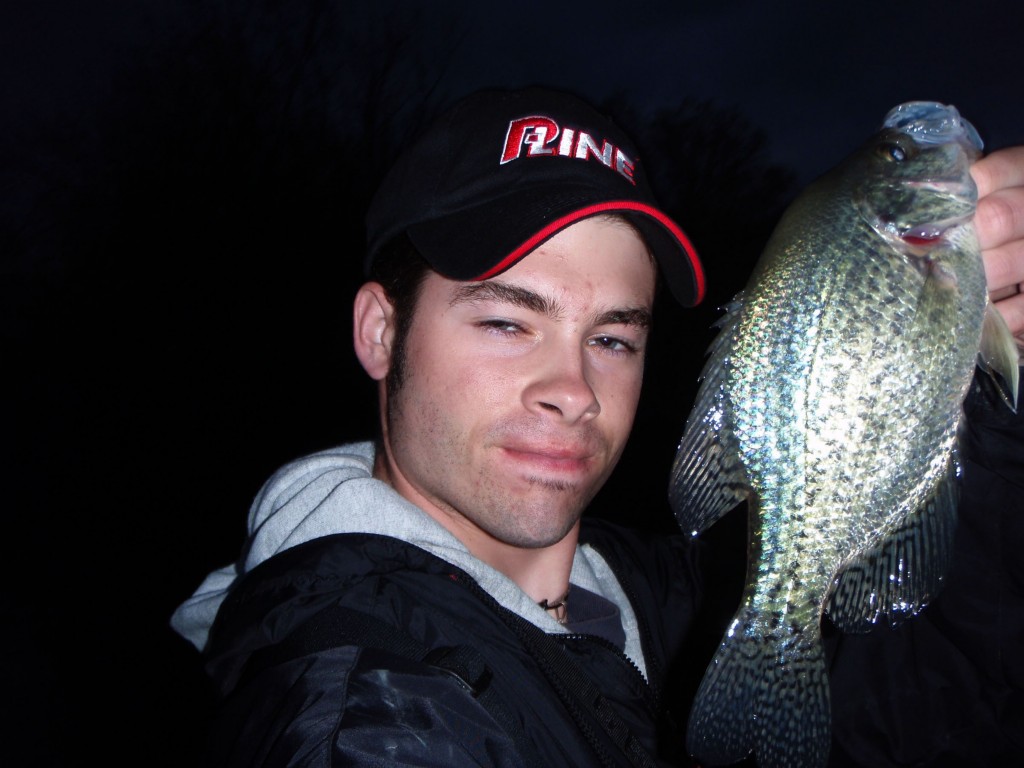
Not only is cover important for crappies, but so is the presence of baitfish. If crappies aren’t migrating due to seasonal circumstances or for refuge, they are on the move for feeding and trailing schools of baitfish. These minnow species will utilize the same wooded and deeper water locations themselves just like crappies do. Wherever you have located the presence of baitfish in areas with good crappie habitat, there is good chance fish will be present somewhere nearby.
When crappies are located, they can be found at almost any depth of the water column. When baitfish are present, they will feed throughout the day with noticeable feeding peaks during the morning and evening hours. My best fishing has often taken place during low light hours such as the afternoons of overcast days, evenings, and sunset.

During their peak periods of feeding, crappies will move into their ambushing and feeding areas for perhaps an hour or so, and will then disperse. When located, fish will usually be caught within 5 to 10 minutes. However, when none are located, it is best to wade on towards the next closest area that is likely to hold fish. It is not easy to predict when crappies will be at any exact location at any given time. However, they can be somewhat predictable once located and a pattern is figured out.
The secret to consistently catching crappies is to stay mobile and fish on the move. If success isn’t had at one area, try another because just as crappies move freely in streams, the angler should do the same. Wade and navigate your way through the water with graceful, careful steps with hopes that fish aren’t spooked by your presence.

Catching Crappies
Keep in mind that when wading your small river for crappies, you are not likely to receive a hard bite. Soft strikes are frequent, and the most common ones will be in the form of a single rapid thump. It’s difficult to explain a crappie’s style of strike, but oftentimes you may wonder if what hit your lure is only a snagged leaf or stick. Whatever it is, be prepared to reel it in anyways, as it is most likely a crappie.
A slip bobber with a small hair jig or minnow might be the best method for some anglers, especially those who have patience or are shore bound and not in the water. But for river wading, the best I’ve found is a 1/16 ounce jig and plastic swimming grub.

Hair jigs and small slip bobber rigs with minnows will work, but the wading style of crappie fishing requires mobility for finding fish, and accurate casting for catching them. For these reasons, the jig and plastic is best. It is a simplistic form of fishing requiring very little skill, but it is exceptionally effective for all situations.
The reason two and three inch grubs work so well is due to the baitfish factor. When retrieved through the current, deeper pools, and wooded areas with a slow swimming retrieve, it resembles the shape and profile of a fleeing minnow. This is an irresistible presentation for the ambushing crappie. Best of all, this lure combination comes fairly cheap. Due to the plethora of snags encountered in wooded river habitats, fishing the jig and plastic is an affordable, cost-effective presentation.

Color selections and style of plastic play an important role in my fishing. I always use natural, realistic colors. My most frequently used colors are motor oil, pearl white, smoke, green pumpkin, clear purple, pumpkin with chartreuse tail, and clear pepper. Sometimes it pays to experiment with different colors. Some favorite soft plastic twister tail grubs that are available in two and three inch sizes with soft tails for maximized action are Producto Spring Grubs, Bass Pro Shops Spring Grubs, YUM Wooly Curltails, Berkley Realistix grubs, and the original Berkley Powerbait grubs.

For wade fishing crappies, my favorite rod for all applications and scenarios is a medium light, fast action spinning rod. Crappies can inhale and exhale baits in a fraction of a second. That is why a light action rod with sensitive tip is important for detecting bites. I frequently wade with two rods at a time; one is a six foot rod and the other is a slightly longer six and a half foot rod. Both serve the same functions and are paired with size 20 Quantum Catalyst reels with 6lb. Cortland Endurance monofilament line. These are my multi-purpose creek and small water rods. They work perfectly not only for crappies but other species of fish which are frequently caught.
Although wading small rivers for crappies is unconventional and sounds unusual, rivers and streams produce great catches of fish for anglers who know how to properly fish them. During the spring and summer months, low gradient rivers and streams can offer a world of success for crappies of quantity and size.
With the concept of catch and release obviously being employed, let me ask you this question relating to crappies: Would you prefer to fish a pressured lake or reservoir that is over fished and over harvested? Or would you rather be one of the few and rare anglers who wades a seldom fished stream that likely somewhere has an untapped, unpressured resource?
If you are one of the rare crappie anglers who prefers wading small rivers over fishing lakes by boat, I congratulate you on the choice you’ve made.



